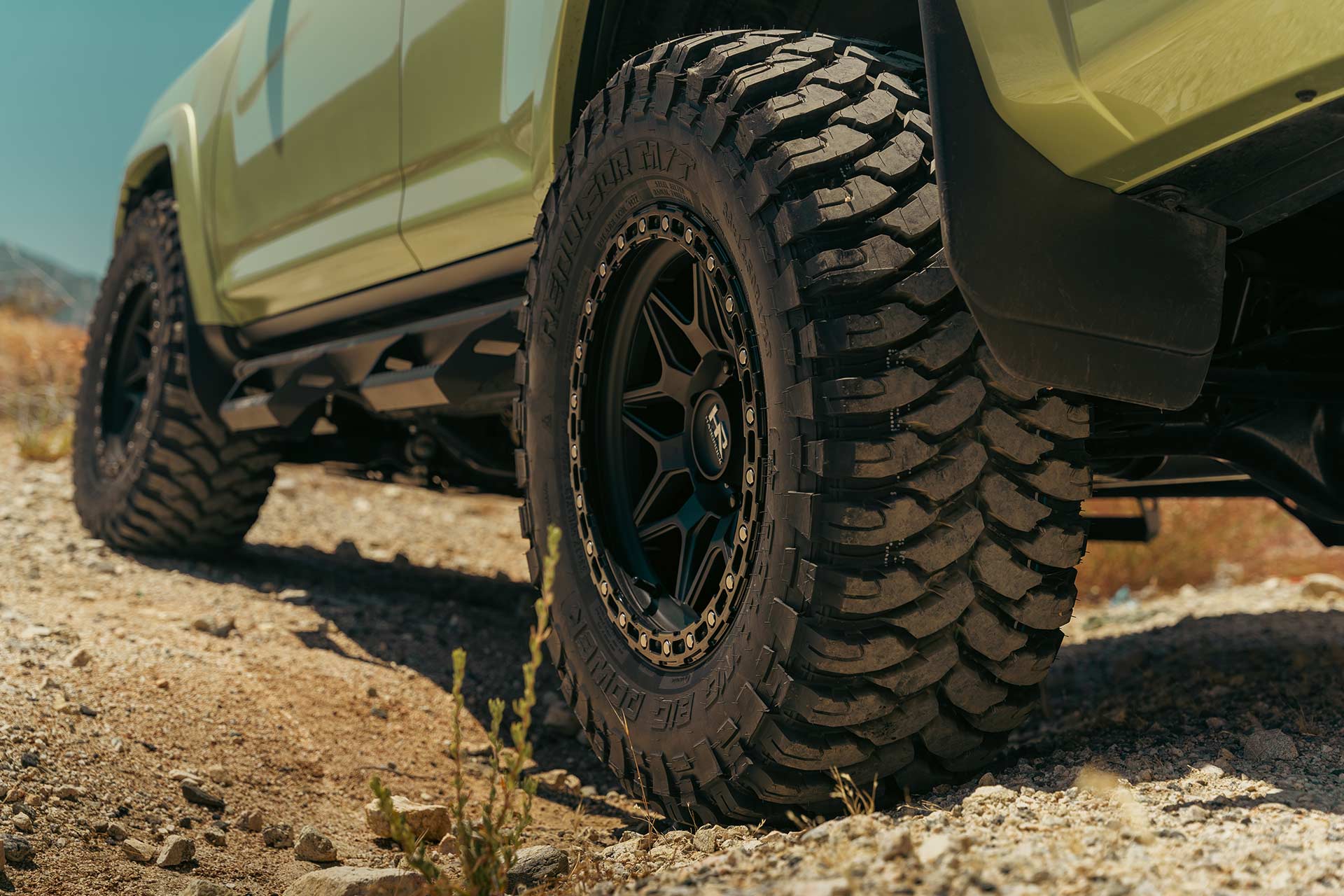Off-Roading Wheel Offset Guide
The difference between a terrible experience on the trails and genuinely good, fun performance comes down to one crucial measurement: off-road wheel offset. Offset determines how your wheels are mounted relative to your suspension and tires, affecting every detail from ground clearance to steering response.
Looking at offset and backspacing measurements can seem like hieroglyphics at first, but once you get to know what it is, how to measure it and what it means in terms of wheel fitment, you’ll eliminate all the guesswork from shopping for new off-road wheels.
The reality is, off-road applications demand specific offset considerations that are drastically different from street cars, creating a unique set of requirements when hitting the trail.
Backspacing or Offset?
Backspacing and offset are essentially the same thing, just measured differently. Both measurements describe the position of the wheel from different reference points. Backspacing measures the distance from the wheel’s back pad to the edge of the rim, while offset calculates the distance from the back pad to the wheel’s centerline.
Although backspacing is still a relevant measurement, these days offset is what you’ll see more of. This is because manufacturers make wheels with pre-determined offsets, meaning the backspacing is consistent with the wheel’s width and offset. This modernization simplifies wheel fitment when looking for a new set of wheels.
Trying to figure out your backspacing measurement? Check out our wheel backspace calculator.
Positive vs. Negative Offset
Positive Offset
Positive offset positions the wheel closer to the suspension, otherwise known as inset. So for example, if a 0 offset is the true center of a wheel, a +1mm offset means the mounting surface, or back pad, sits 1mm closer to the street side of the wheel.
Negative Offset
Negative offset is the exact opposite of that, and creates a more aggressive stance. So, given that the centerline is 0, a -44mm offset means the mounting surface sits -44mm closer to the suspension or hub side of the vehicle.
It sounds confusing, but the easiest way to look at is:
- Positive offsets push the wheel inwards (inset)
- Negative offsets push the wheel outwards (poke)

Popular Offsets for Off-Road Wheels
Choosing the right offset isn’t as simple as picking a number and rolling with it. It comes down to your specific tire size, wheel width and suspension setup. There is no one-size-fits-all solution when trying to fit off-road wheels on your rig. A 17×9 with 35×12.50’s requires a different offset consideration versus a 20×12 with 37×12.50’s. Understanding these relationships helps you pick the perfect balance of aesthetics and performance.
| Offset | Modification Level | Typical Vehicles | Key Characteristics |
|---|---|---|---|
| +1mm |
True Off-Road
Modest upgrade
|
|
Considered a modest upgrade for true off-road look and performance. Maintains warranty considerations while upgrading aesthetics and strength with genuine off-road capability improvements. |
| +0mm |
True Off-Road
Enthusiast favorite
|
|
One of the most popular true, enthusiast-approved off-road setups. Perfect balance of aggressive stance and functional performance without compromising suspension geometry or daily drivability. |
| -12mm |
True Off-Road
Enthusiast approved
|
|
Authentic off-road option used by most enthusiasts. Opens up aggressive tire sizing possibilities while maintaining the functional performance that serious off-roaders demand. |
| -19mm |
Mixed Use
20" wheel common
|
|
Technically works for off-roading but commonly found on 20" diameter wheels. Provides substantial track width increases while remaining manageable for mixed street and trail use. |
| -44mm |
Street/Show
Form over function
|
|
Pretty much exclusively for street trucks and show builds looking for aesthetic upgrades. Prioritizes form over function with dramatic stance changes requiring extensive modifications. |
| -51mm |
Street/Show
Aesthetic focused
|
|
Exclusively for street trucks and show builds where visual impact takes priority over off-road function. Creates unmistakable presence while requiring comprehensive modification planning. |
| -76mm |
Show Only
Pure aesthetics
|
|
Exclusively for show trucks where pure aesthetics dominate all other considerations. Defines extreme positioning for builds where visual impact is the sole priority over any functional performance. |
Fitment & Modification Considerations
What you do with your vehicle significantly influences what offset you go with, as every application demands different compromises between performance, comfort, capability and aesthetics. You wouldn’t fit a 17×9 setup on a show truck, the same way you wouldn’t attempt to off-road with 22×12’s.
The more aggressive (negative) the offset, the more issues you’ll run into when trying to fit not only wheels, but tires. These issues range from fender cutting or shaving, crash bar modifications, extreme lift kits, etc. Plan our your build before buying new wheels to prevent unexpected costs and modifications.
That said, at the end of the day we’re all enthusiasts and we’re all willing to make a specific wheel and tire combo work, no matter what it takes. But if you’re just looking to enhance the look of your truck or SUV, then these considerations needs to be taken seriously.
Mistakes to Avoid
As mentioned above, plan ahead before jumping head first into the deep end. Measure twice and cut once, as they say.
Here’s what you DON’T want to do:
- Ignoring load capacity ratings
- Overlooking tire clearance
- Not checking suspension articulation
- Failing to consider real-world usability and how you use your vehicle
- Not doing research on wheel and tire fitments that are proven to work, such as fitment guides
Hardrock Offroad Wheel Offset Recommendations
Our wheel lineup covers the complete offset spectrum, offering trail-ready wheels to forged truck wheels, engineered with specific applications and uses in mind. Whether you’re building an absolute trail monster to tackle every terrain, or getting your truck show ready, we’ve got a wheel for you.
Below you’ll see some of the most popular options we have, each designed and built with the enthusiast in mind.
Finding Your Perfect Match
Off-road wheel offset represents one of the most important decisions in any build, influencing everything from daily driving comfort to dominating Sand Hollow. The relationship between offset, tire size and suspension setups creates countless combinations, each offering different benefits and compromises. Understanding these relationships, means you’ll be equipped with the knowledge of making the best decision that aligns with your specific goals.
Still unsure on what the hell offset is, and which offset to even go with? No worries, our dedicated team of fitment experts are here to help make the wheel shopping journey as smooth and easy as possible. Just contact us with your year, make and model and we’ll help guide you in the right direction.
Drive it Hard.

